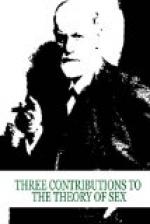Everything relating to the problem of pleasure and pain touches one of the weakest spots of present-day psychology. We shall try if possible to learn something from the determinations of the case in question and to avoid encroaching on the problem as a whole. Let us first glance at the manner in which the erogenous zones adjust themselves to the new order of things. An important role devolves upon them in the preparation of the sexual excitation. The eye which is very remote from the sexual object is most often in position, during the relations of object wooing, to become attracted by that particular quality of excitation, the motive of which we designate as beauty in the sexual object. The excellencies of the sexual object are therefore also called “attractions.” This attraction is on the one hand already connected with pleasure, and on the other hand it either results in an increase of the sexual excitation or in an evocation of the same where it is still wanting. The effect is the same if the excitation of another erogenous zone, e.g., the touching hand, is added to it. There is on the one hand the feeling of pleasure which soon becomes enhanced by the pleasure from the preparatory changes, and on the other hand there is a further increase of the sexual tension which soon changes into a most distinct feeling of displeasure if it cannot proceed to more pleasure. Another case will perhaps be clearer; let us, for example, take the case where an erogenous zone, like a woman’s breast, is excited by touching in a person who is not sexually excited at the time. This touching in itself evokes a feeling of pleasure, but it is also best adapted to awaken sexual excitement which demands still more pleasure. How it happens that the perceived pleasure evokes the desire for greater pleasure, that is the real problem.
Fore-pleasure Mechanism.—But the role which devolves upon the erogenous zones is clear. What applies to one applies to all. They are all utilized to furnish a certain amount of pleasure through their own proper excitation, which increases the tension, and which is in turn destined to produce the necessary motor energy in order to bring to a conclusion the sexual act. The last part but one of this act is again a suitable excitation of an erogenous zone; i.e., the genital zone proper of the glans penis is excited by the object most fit for it, the mucous membrane of the vagina, and through the pleasure furnished by this excitation it now produces reflexly the motor energy which conveys to the surface the sexual substance. This last pleasure is highest in its intensity, and differs from the earliest ones in its mechanism. It is altogether produced through discharge, it is altogether gratification pleasure and the tension of the libido temporarily dies away with it.




